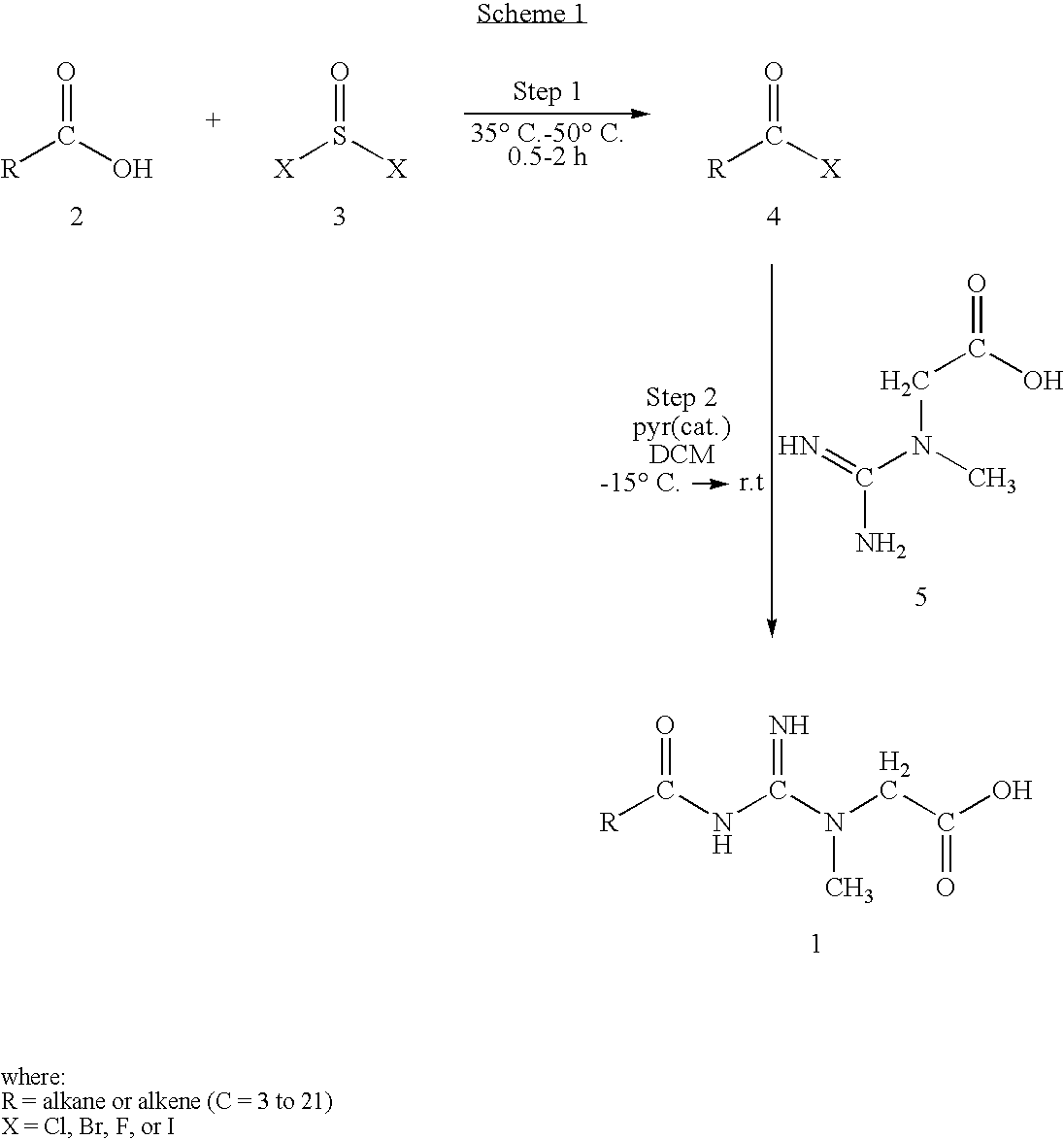Creatine-fatty acids
a technology of creatine and fatty acids, which is applied in the direction of fatty acid chemical modification, drug composition, muscular disorder, etc., can solve the problems of limiting the conversion of creatine to creatine, requiring large amounts of water to be co-ingested, and unrealistic to significantly increase the creatine stores of muscle cells through merely food sources alon
- Summary
- Abstract
- Description
- Claims
- Application Information
AI Technical Summary
Problems solved by technology
Method used
Image
Examples
example 1
2-(1-methyl-3-octanoylguanidino)acetic acid
[0043]
[0044]In a dry 2-necked, round bottomed flask, equipped with a magnetic stirrer and fixed with a separatory funnel, containing 10.07 ml (130 mmol) of thionyl bromide, and a water condenser, is placed 10.30 ml (65 mmol) of octanoic acid. Addition of the thionyl bromide is completed with heating to about 50° C. over the course of about 50 minutes. When addition of the thionyl bromide is complete the mixture is heated and stirred for an additional hour. The water condenser is then replaced with a distillation side arm condenser and the crude mixture is distilled. The crude distillate in the receiving flask is then fractionally distilled to obtain the acyl bromide, octanoyl bromide. This acyl bromide, 4.88 g (30 mmol), is put into a dry separatory funnel and combined with 25 ml of dry dichloromethane for use in the next step of the reaction.
[0045]In a dry 3-necked, round bottomed flask, equipped with a magnetic stirrer, a thermometer, a n...
example 2
2-(3-dodecanoyl-1-methylguanidino)acetic acid
[0046]
[0047]In a dry 2-necked, round bottomed flask, equipped with a magnetic stirrer and fixed with a separatory funnel, containing 13.13 ml (180 mmol) of thionyl chloride, and a water condenser, is placed 20.03 g (100 mmol) of dodecanoic acid. Addition of the thionyl chloride is completed with heating to about 45° C. over the course of about 30 minutes. When addition of the thionyl chloride is complete the mixture is heated and stirred for an additional 45 minutes. The water condenser is then replaced with a distillation side arm condenser and the crude mixture is distilled. The crude distillate in the receiving flask is then fractionally distilled to obtain the acyl chloride, dodecanoyl chloride. This acyl chloride, 7.65 g (35 mmol), is put into a dry separatory funnel and combined with 50 ml of dry dichloromethane for use in the next step of the reaction.
[0048]In a dry 3-necked, round bottomed flask, equipped with a magnetic stirrer, ...
example 3
2-(1-methyl-3-palmitoylguanidino)acetic acid
[0049]
[0050]In a dry 2-necked, round bottomed flask, equipped with a magnetic stirrer and fixed with a separatory funnel, containing 7.75 ml (100 mmol) of thionyl bromide, and a water condenser, is placed 12.82 g (50 mmol) of palmitic acid. Addition of the thionyl bromide is completed with heating to about 50° C. over the course of about 50 minutes. When addition of the thionyl bromide is complete the mixture is heated and stirred for an additional hour. The water condenser is then replaced with a distillation side arm condenser and the crude mixture is distilled. The crude distillate in the receiving flask is then fractionally distilled to obtain the acyl bromide, palmitoyl bromide. This acyl bromide, 16.02 g (50 mmol), is put into a dry separatory funnel and combined with 75 ml of dry dichloromethane for use in the next step of the reaction.
[0051]In a dry 3-necked, round bottomed flask, equipped with a magnetic stirrer, a thermometer, a ...
PUM
| Property | Measurement | Unit |
|---|---|---|
| Structure | aaaaa | aaaaa |
Abstract
Description
Claims
Application Information
 Login to View More
Login to View More - R&D
- Intellectual Property
- Life Sciences
- Materials
- Tech Scout
- Unparalleled Data Quality
- Higher Quality Content
- 60% Fewer Hallucinations
Browse by: Latest US Patents, China's latest patents, Technical Efficacy Thesaurus, Application Domain, Technology Topic, Popular Technical Reports.
© 2025 PatSnap. All rights reserved.Legal|Privacy policy|Modern Slavery Act Transparency Statement|Sitemap|About US| Contact US: help@patsnap.com



